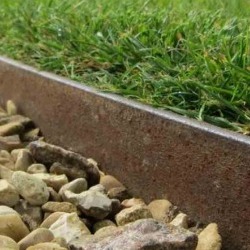Advantages and Features of Our Steel Garden Edging
Unrivalled Strength and Durability
The thickness of steel is one of the most important factors for the strength and durability of steel garden edging. Our 3mm and 6mm thick mild steel edging options offer commercial-grade toughness to last for years.
Easy Installation with Our Unique Joining System
All of our steel edging comes with bolts and an overlapping plate joining system, ensuring no visible fixings on the surface. The overlapping plate is the same thickness as the edge, this ensures curves flow through joins smoothly. The strong nuts and bolt fasteners provide a tight, secure join. With this durable joining system, you can pre-assemble long spans for quick and easy installation.
Simple DIY Installation
Installing our steel lawn edging is a simple process with basic tools. Simply prepare the site, secure the stakes, and tighten the bolts with a 15mm spanner or socket. A drill is only needed when rejoining any cut ends using our joining kit. With multiple height options and internal or external corner pieces, you can achieve any shape or length.
Versatile Height and Length Options
Choose from 5 height options for our 6mm thick steel edging and 3 heights for our 3mm thick steel edging. We also offer custom-length steel lawn edging to meet your specific requirements. You can order them online from our website or contact us.
If you need to cut the edge to length, our joining kit provides a simple means of reconnecting the cut end to the rest of the edge. You can find more information in our installation guide.
Stakes with Enhanced Grip
Our angle iron stakes have a greater surface area in contact with the soil than the more common round stakes, reducing their movement in the ground. The angle iron sleeves surround the stakes providing a secure fit against the edge.
Create Beautiful Curves
One of the many benefits of mild steel is its natural flexibility and its ability to create flowing curves with little effort. Despite its thickness even our 6mm steel edging can create a complete circle with a diameter as small as 4 metres, while the 3mm thick edging can achieve down to 2 meters.
Weathering and Longevity
Upon delivery, your edging will have no rusting. Full weathering of the steel takes 6 to 9 months. Our 6mm edge boasts a lifespan of over 25 years, while the 3mm option exceeds 20 years. Maintenance is generally unnecessary, as we recommend embracing the weathered brown patina of the steel.
Selecting the Right Steel Garden Edging
Consider the Thickness
Our edging is available in two thicknesses, 3mm and 6mm and both are durable. The 6mm option offers extra strength, it’s 20% thicker than competitors’ 5mm edging, making it ideal for high-traffic areas. If you’re interested in finding out which thickness option of steel edging is the perfect fit for your needs, you can check out our article here.
Choose the Height
We offer heights ranging from 75mm to 300mm. Measure your area and determine the desired prominence of your garden border.
We suggest burying half the edging for driveways and paths, therefore the height of the edging needed is determined by how much of it should be visible. Typically, we suggest our 75mm high edging mainly for border applications.
Calculate the Length
Measure the linear footage required for edging and order accordingly. We offer pre-cut lengths and full rolls to accommodate projects of all sizes.
Select Accessories
Our edging comes with the required accessories. You can order corner pieces and jointing kits tailored to your project’s size and site conditions. If you’re unsure about which accessories to use, feel free to check out our article here.
Choose Between Rolls or Pre-Cut Lengths
For large installations, full rolls may be preferable, while smaller projects benefit from pre-cut, easy-to-handle straight lengths.
How to Install Steel Garden Edging Yourself
If you like to do things yourself, our self-fit steel edgings and jointing kits make the process easy, you can choose from:
- steel edging with stakes, sleeves, and welded bolts on the hidden side
- internal and external steel edging corner pieces for angles and curves
- required fixings, joining plates and nuts for connecting sections or corners
Installation Process of Steel Garden Edging
- Prepare the site by digging a trench along the edge.
- Place the steel edge sections in the trench, joining them with plates and nuts.
- Cut and reconnect the edge as needed using the joining kit.
- Fix the edge in place by hammering the stakes through the sleeves.
- Backfill the trench with soil and compact it.
For more detailed instructions, refer to our installation guide.
Installation Tips for Lawn Edging
For lawn edging, we recommend aligning the edge with the height of the soil, allowing the grass layer to rise above the edge. This makes it easy to trim with edging shears or a strimmer.
When to Install During A Landscaping Project?
Two best times to install our steel edging during landscaping:
- Early in the grounds works process after excavating driveways and paths but before adding the subbase. Use the edging to retain hardcore and build up levels inside the border. This provides a clear framework.
- After laying the hardcore base but before compacting. Set edging into the hardcore layer and create a shallow trench. Compact the hardcore then install the final surface.
Build up ground levels on both sides during construction to prevent heavy machinery pressure on one side.
For new borders, install them prior to planting. For new lawns, install before final soil levelling. Use the edging as a guide for soil heights.




.jpg)